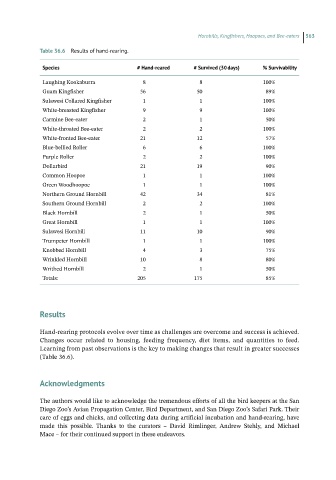Page 563 - Hand rearing birds second
P. 563
Hornbills, Kingfishers, Hoopoes, and Bee-eaters 563
Table 36.6 Results of hand-rearing.
Species # Hand-reared # Survived (30 days) % Survivability
Laughing Kookaburra 8 8 100%
Guam Kingfisher 56 50 89%
Sulawesi Collared Kingfisher 1 1 100%
White‐breasted Kingfisher 9 9 100%
Carmine Bee‐eater 2 1 50%
White‐throated Bee‐eater 2 2 100%
White‐fronted Bee‐eater 21 12 57%
Blue‐bellied Roller 6 6 100%
Purple Roller 2 2 100%
Dollarbird 21 19 90%
Common Hoopoe 1 1 100%
Green Woodhoopoe 1 1 100%
Northern Ground Hornbill 42 34 81%
Southern Ground Hornbill 2 2 100%
Black Hornbill 2 1 50%
Great Hornbill 1 1 100%
Sulawesi Hornbill 11 10 90%
Trumpeter Hornbill 1 1 100%
Knobbed Hornbill 4 3 75%
Wrinkled Hornbill 10 8 80%
Writhed Hornbill 2 1 50%
Totals: 205 175 85%
Results
Hand‐rearing protocols evolve over time as challenges are overcome and success is achieved.
Changes occur related to housing, feeding frequency, diet items, and quantities to feed.
Learning from past observations is the key to making changes that result in greater successes
(Table 36.6).
Acknowledgments
The authors would like to acknowledge the tremendous efforts of all the bird keepers at the San
Diego Zoo’s Avian Propagation Center, Bird Department, and San Diego Zoo’s Safari Park. Their
care of eggs and chicks, and collecting data during artificial incubation and hand‐rearing, have
made this possible. Thanks to the curators – David Rimlinger, Andrew Stehly, and Michael
Mace – for their continued support in these endeavors.

